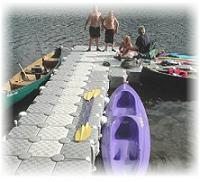

Dunn's Fish Farm is proud to offer Docks by
Candock. Candock has designed a
revolutionary
floating dock
system that will take the hassle, maintenance and
guesswork out of building, designing and enjoying
your own dock. This Floating Modular Dock system is
not
only versatile and functional, but with it's limited
lifetime warranty is guaranteed to stand the test of
time.
This innovative design is
environmentally friendly and has unlimited possibilities!
Find out more....
Quick Links...
MORE GREAT PRODUCTS!
|
|
Greetings!
Recent news of the damage Hurricane Katrina and
Hurricane Rita did to the Gulf Coast did not include
any major fish kills. However, hurricanes
can and do kill fish, especially in small ponds. Since
it is still the busy part of hurricane season, this
article will discuss how these storms cause fish kills.
|
|
Summer Pond Dynamics
|
|
Summer, which coincides with hurricane season,
causes water in a pond or lake to form layers of
varying temperatures with the warmer (or lighter)
water on top. If you’ve ever been swimming in a
pond during the summer you have probably noticed
this phenomenon. Your upper body would be in sun-
warmed water and your feet and legs in cold water.
The warm water reaches to a depth that sunlight
can penetrate and drive photosynthesis, which is
usually around a depth of 6 feet. In some soft water
lakes, the upper layer may extend to 22 feet (here is
where we are assuming that you have limed your
pond to increase the hardness and alkalinity). In
managed ponds, sunlight should only be able to
penetrate 18-24 inches. Since this top layer of water
is where photosynthesis takes place, it is also where
oxygen is being produced; however, warm water
holds less oxygen than cold water. In the summer,
the top layer of water may be saturated with 5 ppm
(parts per million) dissolved oxygen commonly
referred to as D.O. At 3 ppm fish will start to die.
Oxygen in cold water at the bottom is quickly used
by rotting detritus (remains of something that has
been broken down such as leaves, plant matter,
etc.) and is not replaced. The cooler temperatures
that come in the fall cause the varying degrees in
the water to mix until they are almost the same
throughout. They remain mixed until the following
summer’s heat causes the water to layer out again.
|
|
Hurricane Effects
|
|
Most people think that rain water splashing on the
surface of a pond is enough to add oxygen. This is
true to an extent, but it isn’t enough. The problem is
that when it rains for several days at a time, the sun
is blocked and not able to drive photosynthesis to
produce oxygen. Splashing rain is not enough to
overcome this loss. A hurricane has winds strong
enough to mix the layers of water in a pond, even
when the temperature differences are great. If the
top water has an estimated 5 ppm of D.O. and the
bottom is 0 ppm D.O., then when they are mixed the
combined oxygen may only be 1-3 ppm. That’s when
the fish begin to die. In a low oxygen kill the larger
fish usually die first. Smaller fish can sometimes get
enough oxygen diffusing into the very surface of the
water from the air, but not always. Fish that die from
lack of oxygen
will have flared gills and open mouths. The same is
true of gill parasites and other diseases but these are
not caused by hurricanes. If you’ve seen film of the
toxic water in New Orleans, you can understand how
these toxins can also cause fish kills. Fish kills from
poisons will generally kill fish of any size. It is also
possible that some toxins might get blown into or run
into your
pond, but lack of oxygen is more likely the culprit.
|
|
Fish Kill Prevention
|
|
Just like the damage to the Gulf Coast, there is not
much you can do to prevent a hurricane from hurting
your pond’s fish population. If you have the
capability, you may be able to pump well water into
the pond for cooling. Caution must be used when
doing this as well water doesn’t contain dissolved
oxygen. Water can also be pumped from the bottom
of your pond and discharged on the surface, but this
method is just as risky as bottom water seldom
contains oxygen. If you don't have an aeration
system in place, you can reduce the risks associated
with this problem by oxygenating
water in various ways: 1) Use a piece of capped PVC
pipe and drill small holes in the cap. This can then be
used to form a fountain. 2) Suspend a vertical piece
of pipe above the surface of the water and fill with
large gravel. Hold the gravel in place by using a piece
of hardware cloth and run water through the pipe.
Either of these two methods will break the water into
small droplets. This will break up the water into
smaller drops that have more surface area and
therefore can absorb oxygen quicker. 3) If you have
an aerator you can run it if electricity
is still available or if you have the use of a generator.
|
|
|

